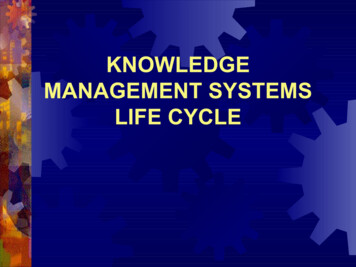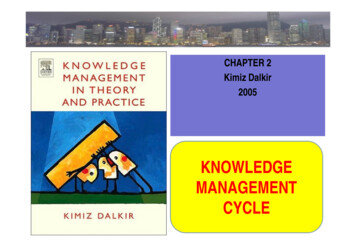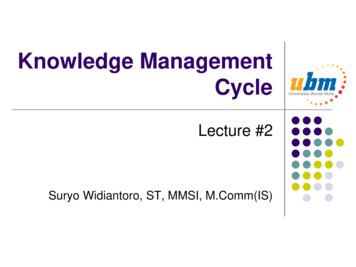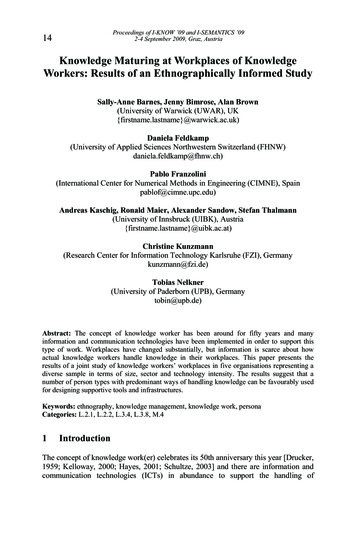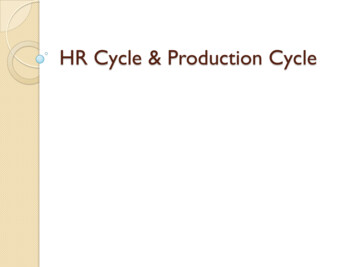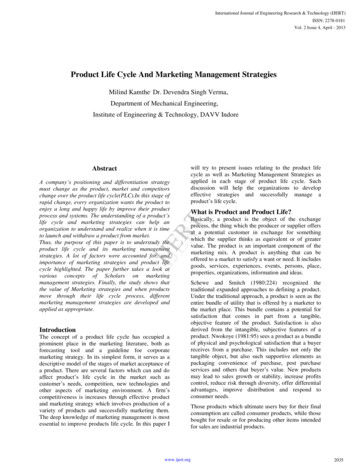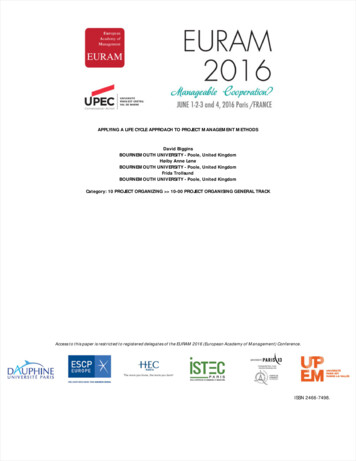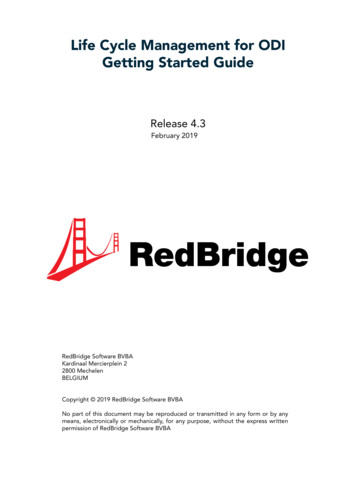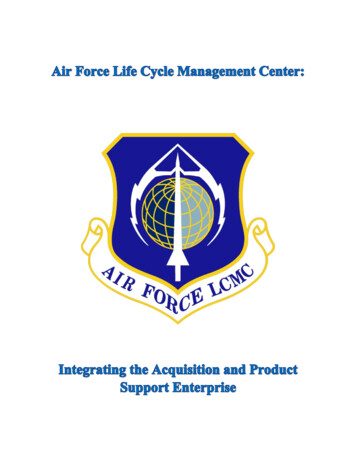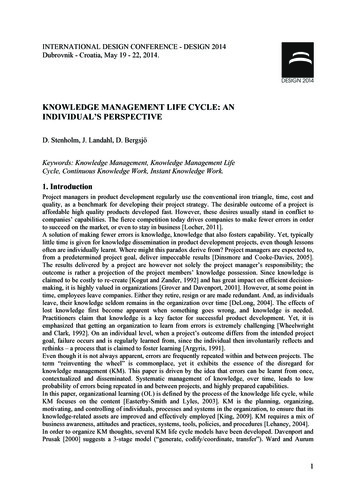
Transcription
INTERNATIONAL DESIGN CONFERENCE - DESIGN 2014Dubrovnik - Croatia, May 19 - 22, 2014.KNOWLEDGE MANAGEMENT LIFE CYCLE: ANINDIVIDUAL’S PERSPECTIVED. Stenholm, J. Landahl, D. BergsjöKeywords: Knowledge Management, Knowledge Management LifeCycle, Continuous Knowledge Work, Instant Knowledge Work.1. IntroductionProject managers in product development regularly use the conventional iron triangle, time, cost andquality, as a benchmark for developing their project strategy. The desirable outcome of a project isaffordable high quality products developed fast. However, these desires usually stand in conflict tocompanies’ capabilities. The fierce competition today drives companies to make fewer errors in orderto succeed on the market, or even to stay in business [Locher, 2011].A solution of making fewer errors is knowledge, knowledge that also fosters capability. Yet, typicallylittle time is given for knowledge dissemination in product development projects, even though lessonsoften are individually learnt. Where might this paradox derive from? Project managers are expected to,from a predetermined project goal, deliver impeccable results [Dinsmore and Cooke-Davies, 2005].The results delivered by a project are however not solely the project manager’s responsibility; theoutcome is rather a projection of the project members’ knowledge possession. Since knowledge isclaimed to be costly to re-create [Kogut and Zander, 1992] and has great impact on efficient decisionmaking, it is highly valued in organizations [Grover and Davenport, 2001]. However, at some point intime, employees leave companies. Either they retire, resign or are made redundant. And, as individualsleave, their knowledge seldom remains in the organization over time [DeLong, 2004]. The effects oflost knowledge first become apparent when something goes wrong, and knowledge is needed.Practitioners claim that knowledge is a key factor for successful product development. Yet, it isemphasized that getting an organization to learn from errors is extremely challenging [Wheelwrightand Clark, 1992]. On an individual level, when a project’s outcome differs from the intended projectgoal, failure occurs and is regularly learned from, since the individual then involuntarily reflects andrethinks – a process that is claimed to foster learning [Argyris, 1991].Even though it is not always apparent, errors are frequently repeated within and between projects. Theterm “reinventing the wheel” is commonplace, yet it exhibits the essence of the disregard forknowledge management (KM). This paper is driven by the idea that errors can be learnt from once,contextualized and disseminated. Systematic management of knowledge, over time, leads to lowprobability of errors being repeated in and between projects, and highly prepared capabilities.In this paper, organizational learning (OL) is defined by the process of the knowledge life cycle, whileKM focuses on the content [Easterby-Smith and Lyles, 2003]. KM is the planning, organizing,motivating, and controlling of individuals, processes and systems in the organization, to ensure that itsknowledge-related assets are improved and effectively employed [King, 2009]. KM requires a mix ofbusiness awareness, attitudes and practices, systems, tools, policies, and procedures [Lehaney, 2004].In order to organize KM thoughts, several KM life cycle models have been developed. Davenport andPrusak [2000] suggests a 3-stage model (“generate, codify/coordinate, transfer”). Ward and Aurum1
[2004] advocate a 7-stage model (“create, acquire, identify, adapt, organize, distribute, apply”). Also,the SECI framework for knowledge creation (“socialization, externalization, combination,internalization”) [Nonaka, 1994] is well known.1.1. Post-project reviews as a concept for organizational learningSome practitioners suggest applying ‘lessons learned meetings’ in the end of every project [Mascitelli,2007] in order to prepare dissemination of knowledge into the organization. The concept is used inproduct development and is also referred to as post-project reviews. However, it has been found thatpost-project reviews carry at least four malfunctions: Typically carried out in the end of a project [Kotnour, 2000], when much of the projectlearning has already been forgotten Typically conducted by one individual, often the project manager [Busby, 1999, Kotnour,2000, Williams, 2008] There is a lack of useful input, and input is often stated in general terms [Bresnen et al., 2003] The outcome is regularly a large, inaccessible record [Von Zedtwitz, 2002, Schindler andEppler, 2003, Parry and Turner, 2006]The concept of post-project reviews might be a useable model since it considers constructingindividual knowledge into organizational knowledge. However, it can clearly be further elaborated.The four bullet points above indicate that post-project reviews include risks of being ineffective. Andsince post-project reviews are widely used in product development, these projects are seldom aseffective as they could be. Effectiveness in this case can be defined as a low chance of error. Fewererrors ideally indicate shorter lead times, lower development cost and better product quality.An elaboration of post-project reviews suggests that many individuals’ knowledge can feed aknowledge repository continuously between projects. This deduction is however not revolutionizing.The concept of continuous improvements is known and thoroughly deliberated in research, forexample in the concept of the knowledge value stream [Kennedy, 2008], the approach of Kaizen or,more specifically about post-project reviews, by von Zedtwitz [2002].1.2. Technology platform and known barriers in human interaction with KM systemsTo categorize and capture organizational knowledge, a knowledge repository is typically applied. Inthis paper it is represented by a technology platform solely composed by knowledge records of explicitknowledge [Levandowski et al., 2013]. The knowledge is exclusively related to technologiesdescribing product and manufacturing systems. It is designating the link between product systems andmanufacturing systems, by the communication between man-computer, computer-computer andcomputer-man. The knowledge records are delimited to describe manufacturing systems capabilities,guidelines of “know how” [Levandowski et al., 2013] and ISO as well as corporate standards, in aproduct development context.The objective of a KM system, including the technology platform, is to support the KM life cycle andin that sense support individual creation, transfer, and application of knowledge in organizations[Alavi and Leidner, 2001]. However, there are several barriers connected to human interaction withKM systems. Project members regularly have unrealistic expectations on KM systems, that the systemalone will do the work of sharing knowledge. There might be an inappropriate technology integration,mismatching the project members’ needs, adoption, support, IT project management, upgrades andcosts [BenMoussa, 2009]. Any implemented method must support knowledge to be updated,accessible and available for the personnel within the organization [Davenport and Prusak, 2000]. It isfurther claimed that specific knowledge records need an owner to be completed. Several definitions onknowledge ownership exist. In this paper it is defined as the one responsible for the accuracy of theknowledge content and ensuring its validity over time [Jarvenpaa and Staples, 2001].2
2. Research approachIn the field of KM we can distinguish the challenge of absorbing valuable knowledge, not exclusivelyshort-term, relying solely on knowledge in project members’ minds (whether it is compiled facts or“know-how”), but also long-term. The long-term perspective of caring for individuals, respecting theirknowledge, while at the same time exploiting it, is a balancing act. However, we believe that anappropriate KM life cycle might be useful for visualizing how individuals can contribute to thecompany’s aggregate knowledge capabilities.This study is both descriptive and prescriptive. It is descriptive in the sense that industrial issues areanalyzed and contextualized within the framework of the integration between product designers andmanufacturing engineers, where the link between them is represented by the technology platform. TheKM life cycle is described from an individual’s perspective in order to understand the knowledge userand creator, which is why project managers may find the model appealing. The research is prescriptivesince the approach is founded on systematic mapping of industrial KM issues, where incentives to findpractical solutions are presented. The findings include discussions on how to overcome core barriers.In incremental product development projects, the communication between product developers andmanufacturing engineers is not as effective as it could be. Knowledge can be lost in translation, due toseveral reasons. We believe that by investigating the current state of practice in two case companiesand by mapping empirical data and related theory, we will be able to distinguish possible solutions toexploit many individuals’ (project members’) created knowledge in and between projects. This paperis hence driven by the two following research questions:1. What core barriers, that restrain an ideal-working KM life cycle, exist at the case companies?The empirical data is analyzed and an ideal KM life cycle from an individual’s perspective ispresented. Core barriers are identified. The barriers are then mapped into a proposed KM lifecycle model, described from an individual’s perspective.2. How can core barriers be overcome?From the mapped core barriers, solutions to overcome some of the barriers are proposed.The research is delimited from the process of individual knowledge creation, since this particularprocess is difficult to systemize. The KM life cycle in this paper is seen from an individual’sperspective in order to understand the user. Organizational knowledge intends to denote theknowledge that is continuously fed into the technology platform. What we mainly want to deliberateupon is a technology platform as a link between product developers and manufacturing engineers. Theprocesses of “acquiring”, “refining”, and “transfer/sharing” knowledge, in and between projects, are ofparticular interest.2.1. Studying two case companiesIn this paper we will elaborate on the current practice at two large technology driven companies,Toyota Material Handling Europe (TMHE) and Volvo Car Corporation (VCC), both dependent ontheir product development efforts. The two companies’ product development departments are locatedin Sweden. The characteristics of the two are presented in Table 1.The dissimilarities between the two companies were intentionally chosen. This choice was motivatedby the need to see if and how, knowledge management requirements differ between industry sectors,market segments and customer relations. Three case studies were conducted in order to substantiatetheory and collect data to answer the research questions. Eleven interviews at TMHE (2011-2012), teninterviews at VCC (2013), and then nine follow-up interviews at TMHE (2013) were conducted. Theinterviewees consisted of product developers, quality engineers and senior-level managers, all affectedby how knowledge is managed in product development projects. The interviews were transcribed andverified by the interviewees. The results were thereafter analyzed and categorized, where core barrierswere mapped within a proposed KM life cycle model. Further, as a second phase of the study, theinterviewees were invited to a workshop in order to discuss the results for internal consistency. As aconcluding stage, a final presentation was held at the case companies to validate the results. Theinternal and external acceptance of the findings indicates possible high impact of this study on thefuture of KM within product development.3
Table 1. Characteristics of the two case companies.CharacteristicsTMHEVCCMarket SegmentPremium/volumePremium/customizedCustomer RelationB2BMainly B2CProduced units55 000449 000Market ShareLargeSmallTurnover4 000 M SEKProductsPlatform/ModularIndustry SectorIndustrial equipment107 000 M SEKPlatform/Integrated cal/ElectricMechanical/CombustionProcessSemi automated, Flow/KanbanHighly automated, Flow/KanbanNumber of Employees9000210003. Empirical data and analysisThe conducted interviews at the two case companies have given insight into the current state ofpractice of KM in product development. Between projects within each of the two companies, there is aconsistent approach on how to make knowledge reusable, namely by post-project reviews. However,organizational learning might be a dysfunctional process. Some of the most critical questions andcorresponding answers from the interviews and workshops are given in Table 2.Table 2. Representative questions and answers derived from interviews and workshopsInterview QuestionTMHE AnswerVCC AnswerHow is knowledge generallycaptured in projects?Post-project reviewsPost-project reviewsHow is the capturing ofknowledge regulated?Moderately regulatedStrictly regulatedHow is OL affected by thechoice of capturingknowledge?“We end up with a bunch of differentknowledge records that no one uses”“Every project writes the samelessons learned, so we do not learn asan organization”How well is ‘previouslycreated lessons learned’utilized?“When I search for it I can’t find it,so I ask someone who might know””Post-project reviews are oftenforgotten”What is the main reason forknowledge not beingcaptured?“When we perform post-projectreviews, individuals tend to be drawninto new projects before theirlearnings are captured”“Lack of time”“We do not see the future use of it”Why is it difficult to gainaccess to knowledge?“The system is slow””All the information is available, butthe landscape of the systems is asscattered as the organization”The data collected in this study has contributed to the idea that, since individuals create newknowledge, the aggregate lessons learned from a project is a projection of the project members’knowledge. This reasoning resulted in a KM life cycle described from an individual’s perspective andthe idea that barriers can be correlated to this model. Additionally, it was understood that there is a4
distinction between individual benefit and future user benefit of utilizing knowledge. This reasoning isfurther discussed below.3.1. Presenting a KM life cycle model from an individual’s perspectiveKM life cycles are typically described from a broad perspective [Davenport and Prusak, 2000, Wardand Aurum, 2004]. Conversly, in this paper a strict connection between an individual and theknowledge life cycle is proposed and presented, see Figure 1. This proposed model is based on theoryand empirical data. It has its base in organizational knowledge, represented by the technologyplatform, and follows the individual knowledge application involving four processes (“acquisition”,“creation”, “refinement”, “transfer/sharing”) and three decision points (“knowledge reused”,“knowledge created”, “knowledge captured”). In every decision point, the individual is encouraged totake action on what the past process has given and how to move on to the next. The process of“creation” is not focused upon in this paper.IndividualKnowledgeIndividual benefit Future user benefitNew knowledgegainedKnowledgeCreatedKnowledge reusepotential realizedcbKnowledgecodifiedKnowledge leknowledgeunderstoodKnowledgerecord efinementTransfer/sharingFigure 1. The proposed KM life cycle, presented from an individual’s perspective.The processes are described from an individual’s (project member’s) point of view. It describes howthe individual travels in the model domain – searching for knowledge in the technology platform,understanding knowledge records, detecting a knowledge gap, closing the gap by creating newknowledge, codifying the knowledge into a record and finally making new knowledge available byfeeding it back into the technology platform. In an ideal process, certain barriers are overcome alongthe way, or no barriers exist. However, an ideal process is seldom genuinely representative. What ispossible though, is to move towards the ideal process.5
The identified core barriers in this paper have been derived through analysis of the empirical datacollected from the two companies and the three case studies. The core barriers are mapped into theprocesses of the presented KM life cycle model, see Figure 1.There is also a mind-set change included in the model in order to distinguish the individual’scontribution to the company’s aggregate knowledge capabilities. The first half (“search” to “newknowledge gained”) describes the processes (“acquisition” and “creation”) from an individual benefit(short-term) perspective (“what knowledge do I need?”, “what is the benefit for my work?”, etc.). Theknowledge that is missing, to complete a task, has to be created for own benefit (see process“creation” in Figure 1). However, the second half of the model (from “knowledge reuse potentialrealized” to “knowledge codified”) describes the processes (“refinement” and “transfer/sharing”) froma future user benefit (long-term) perspective (“what knowledge do future users need?”, “what is thebenefit for future user’s work?”, etc.). This mind-set is summarized in Table 3 below.Table 3. The first half of the proposed KM life cycle describes a mind-set from an individual benefit(short-term) perspective. The second half describes a mind-set from a future user benefit (long-term)perspective. This is illustrated by presenting questions related to each tangent point (“search” or“knowledge available”) of the technology platform.Which knowledge do Where do What keywords do Shortterm I need? I search? I search for?Longterm future users need? future userssearch? future users searchfor?How do I apply locatedknowledge? future usersapply locatedknowledge?The preparation work done by an individual during the “refinement” and “transfer/sharing” processeswill be the basis for the “acquisition” process for another individual. Therefore these processes are ofgreat interest.3.2. Identifying and mapping core barriersThe present practice at the case companies for measuring effectiveness of a product developer or aproduct development project does not involve working with KM such as post-project reviews orlessons learned. Without dedicating time or receiving encouragement from managers for these efforts,other tasks become more important to deal with. The interviewees state that there is (1) lack of timeand they point out that they are already overloaded. The tasks concerning KM are often given lowprioritization.Incremental development implies designing and improving products. A preconceived opinion is thatreusing knowledge will constrain the possibility to develop better products that represent thedeveloper.a) Process: acquisitionKnowledge acquisition involves the search, recognition, and the assimilation of potentially valuableknowledge until it is understood. In this context it aims at describing knowledge acquired from thetechnology platform that has been embraced and understood. The KM life cycle is seen from theperspective of individual interaction in relation to the technology platform. Acquisition therebyincludes internal search of knowledge that is seized in the organization’s memory – the technologyplatform. Grafting (adding desired knowledge from outside in the form of an individual) and searchingfrom external sources, that are not included or linked to the technology platform, are parts of thecreation process which is different from Huber’s definition of acquisition [Huber, 1991].Se
Systematic management of knowledge, over time, leads to low probability of errors being repeated in and between projects, and highly prepared capabilities. In this paper, organizational learning (OL) is

